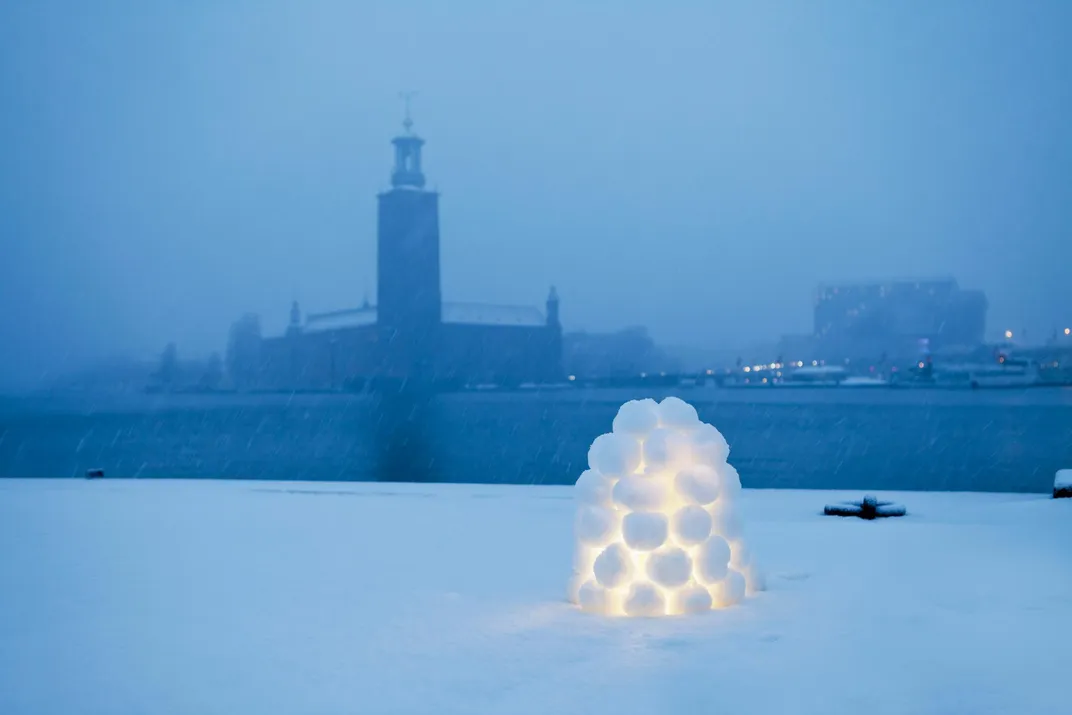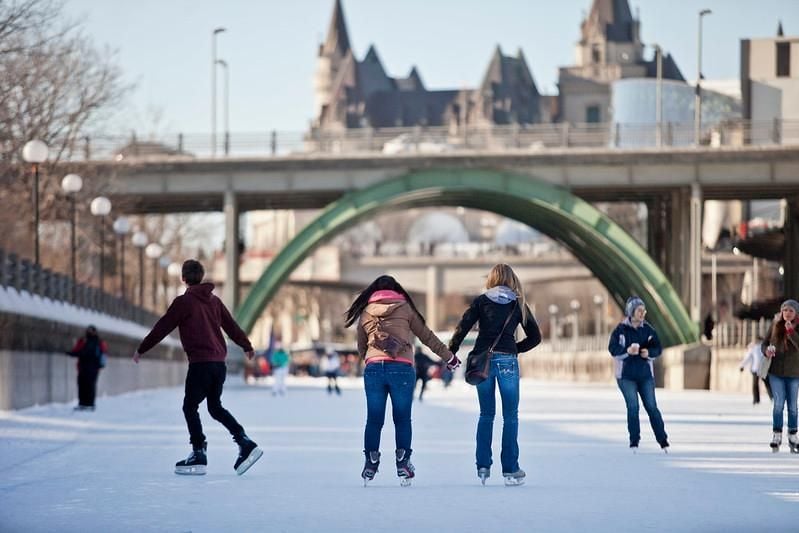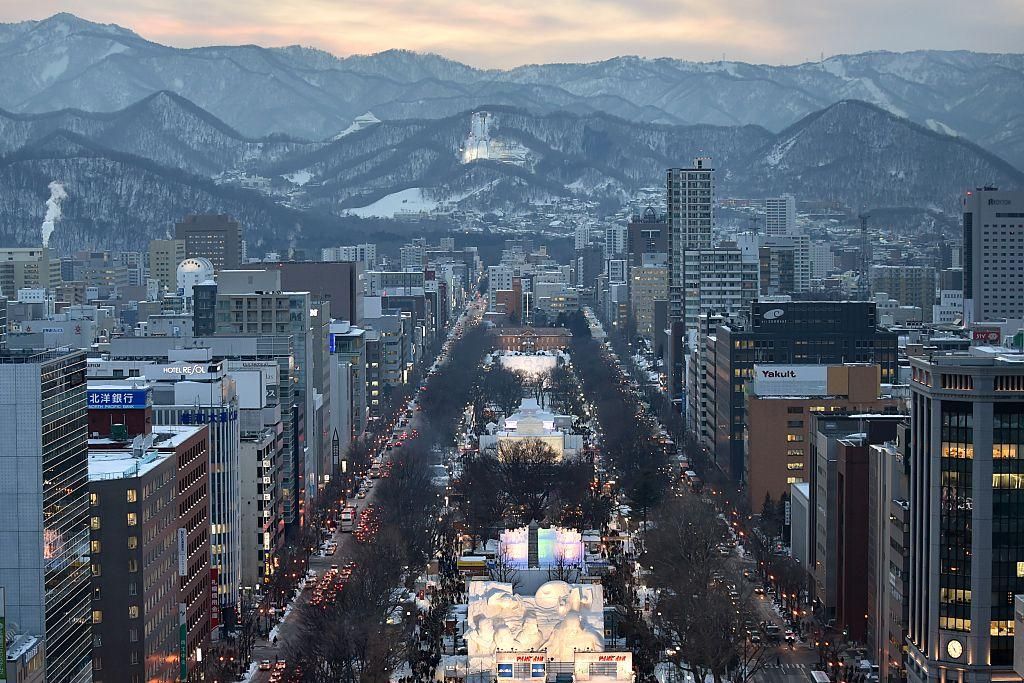What Americans Can Learn From Winter-Loving Cultures
With large indoor gatherings off-limits, the Covid-19 pandemic is giving everyone more reason to stay outside
/https://tf-cmsv2-smithsonianmag-media.s3.amazonaws.com/filer/42/7e/427e2f7f-74af-43a4-8931-f9da55bfea32/ice_swimming_at_sauna_in_finland-main.jpg)
Several years ago I found myself in Norway at the height of winter. The snow was falling around Oslo, the country's capital, but the frigid temperature didn't stop local residents from enjoying the outdoors. In fact, it almost encouraged them. There were plenty of people exploring the city's sculpture-filled Frogner Park on cross-country skis, strolling atop the snow-blanketed (and pedestrian-friendly) rooftop of the striking Oslo Opera House, and snuggling together by the sea. At one point I even joined several Norwegians on a mid-afternoon horse-drawn wagon ride to a secluded spot in northern Oslo’s Nordmarka wilderness region. Once there, we built a campfire—a flaming orange and red contrast to the white-powdered forest surrounding us—and then huddled around it, drinking mulled wine and frying hot dogs on sticks. I felt happier and more content than I had in a long while, despite that day's temperature high of only 16 degrees Fahrenheit.
What was it about experiencing Norway in all its wintry glory that had me smiling from ear-to-ear?
“There's a real idea of balance in Nordic countries,” says Leslie Anne Anderson, director of collections, exhibitions and programs at the National Nordic Museum in Seattle, Washington. “One that includes the tendency to get out into nature—whatever the weather or season—and taking the time and space to unplug.” In fact, despite a shorter-than-average number of winter daylight hours, Nordic countries consistently top the ranks of the world's happiest countries. The residents of Denmark, Norway, Sweden, Iceland and Finland are not only justifiable experts at staving off the winter blues, but they're also extremely well-versed in using outdoor environments to their advantage—making them examples for people around the world this winter, with the continuing pandemic keeping large indoor gatherings off-limits and giving the global community more reason to stay outside.
Friluftsliv is the Norwegian concept of “outdoor living,” or embracing the natural outdoors whatever the weather. “It encompasses everything from cross-country skiing through a local park to mountain biking in the snow,” says Synne Kvam, the communications manager at Norsk Friluftsliv, Norway's association of outdoor organizations. But this notion of “free air life,” as it translates in English, is about much more than the activity alone. “Relaxing, being in and observing the quiet of nature, even enjoying the smell of coffee cooking over a campfire,” says Kvam. “These are also considered friluftsliv.”
Another prominent Nordic concept or characteristic that Americans might consider this winter, says Anderson, is hygge. It's that feeling of coziness you might get when you're reading a good book by the fire, or sipping wine with a group of childhood friends. “Hygge is an easy philosophy to adopt, especially if you're in a colder climate,” Anderson says, “and it's something you can even adapt for the outdoors.” Crawl into your warm-weather sleeping bag and tent for a bit of winter camping, she says, or bundle up under a heavy blanket to take in an evening of stars.

Here in the United States, we can learn a lot from the ways that Nordic countries embrace winter. In countries like Denmark and Finland, some parents put their babies outside to nap in their strollers—even in subzero temperatures—a long-standing cultural practice that they believe helps strengthen their families well-being. For adults, avantouinti, or ice swimming, is a more common activity, not-to-mention a fantastic immune booster, especially when a freezing dip in a lake or pool is preceded by a hot steam in a sauna, or a hot tub soak. This is particularly true in Finland, which is home to approximately three-million saunas. The cold water helps increase the heart rate and kick up circulation, while the warmth soothes muscles. As Graeme Jones, founder and CEO of Nordic Clinic Stockholm, puts it: "Environmental challenges in short doses, like heat, cold and fasting, activate our survival mechanisms that can extend lifespan and ward off chronic disease.”
According to Tim Frandy, assistant professor of Folk Studies at Western Kentucky University, many of those participating in this type of hydrotherapy in Finland are middle-aged and elderly women. “They will methodically step out of the sauna and then go down a ladder into freezing cold water without making a peep, swim back and forth a few times, and then climb back out of the water,” he says. “It’s so meditative, and in such contrast to the polar bear plunges we have here, where people jump clothed into the water, scream, and then quickly rush out.”
Frandy is a member of the Sámi American community (Sámi are the indigenous peoples of Northern Scandinavia and Russia’s Kola Peninsula), and growing up in northern Wisconsin, his family incorporated many of the traditions of their Sámi culture and heritage into their daily lives. “I was cross-country skiing from the age of two,” he says, “and we snowshoed regularly through the woods. There are also a ton of lakes in the Midwest, so we got a lot of our food through ice-fishing.” Frandy says that one of the most important lessons he inherited from the Sámi community is that “We don’t let cold weather stop us from living.”
In countries like Finland, Norway and Sweden, where the winter days are short and the season’s long, this includes activities like building a snölykta, or brightly lit snow lantern, in heavy snow; taking long walks through woodlands (“and putting grips on our shoes if necessary,” says Kvam); and foraging for wild winter foods such as crabapples, juniper berries and pine nuts.
“Something that Nordic countries have is access to large tracts of lands,” says Frandy. This is known as “Everyman’s Right,” or the freedom to roam the countryside on both public and private properties, no matter who owns it.
“This means we can sleep in a tent [or a conical lavvu, a traditional Sami shelter that’s similar to a tipi], light up a campfire, or take a contemplative stroll without headphones or distractions, and just let our minds wander,” Kvam says. “It definitely makes it much easier to enjoy life outside.”
“I think Nordic countries have shown us a way to grow and be adventurous in what might initially seem like adverse weather conditions to many,” says Anderson. “But really, there's something to be said for watching a truly impressive snowfall in the company of others, or finding solitude in nature on a cold winter's day, all the while allowing yourself a little time to recharge.” Anderson suggests thinking about those things that take you out into nature, whether it's an energizing activity like sledding or snowshoeing, or something more leisurely such as collecting chestnuts that you can roast in the oven later.
“It’s all about figuring out what kinds of activities you’re interested in,” says Kvam, “and then maybe finding someone to share the experience with you on a regular basis. If it’s something you’ve never tried before, like cross-country skiing or snow-biking, see what you can learn from somebody who’s been doing it for a while.”
Other Countries that Do Winter Well
While the Nordic countries are obvious experts at facing harsh climates head-on, they're not alone in their ability to make the best out of winter's cold temps. Here are four other countries that can teach us a lot about embracing the outdoors this winter season:
Lithuania
“Storytelling is a very popular pastime in winter,” says Renata Stanaityte, a native Lithuanian who grew up in the city of Alytus and is about to move back to her home country after several years in London. “We do the majority of our chores during the day, then spend cozy evenings with our families telling familiar folktales, usually while sipping hot tea with berries we'd picked in the summer.” While Stanaityte admits that such nights of storytelling typically take place inside, it's also a tradition that can be easily adapted to backyard bonfires and camping trips in the snow.
Since Lithuania is home to nearly 3,000 lakes, local residents also take full-advantage of ice fishing, a Baltic tradition that involves drilling a hole into ice that's formed over water, baiting your line and simply waiting for the fish to come. However, the country's most rewarding winter practice just may be that of bringing food to wild animals such as deer, wild boar and hare, on the season's coldest days. “Usually newscasters will offer advice on where they might need help and what kinds of food we can bring them,” Stanaityte says. For deer, local residents typically leave out hay on an elevated surface, sometimes even building a makeshift hay rack in which to store it. Other foods include potatoes, grains and carrots. “We’ve always had a strong connection to nature here,” she says. “This is just one small example.”
Canada

Our neighbors to the north can definitely teach us a thing or two when it comes to making the most out of winter, from ice-skating as a form of transport in Ottawa to fondue gatherings throughout Quebec province, where this delectable pot of melted cheese is just as delicious around an outdoor bonfire as it is indoors. The eastern island of Newfoundland has a handful of winter traditions, including the “boil-up,” which is essentially a break taken in nature that involves brewing tea over an open fire. “You bring a kettle or an old fashion pot for tea-making, and you often have some baked beans warming up as well,” says Canadian Danielle Paquet, who grew up in Quebec City and now resides in Halifax, Nova Scotia. There's also “mummering,” a holiday tradition in which local residents dress in costume and go from house to house, performing music or a short play in the hopes of receiving food and drink (think whiskey and Vienna sausages) in return. Typically it's in the form of an impromptu house party, but in the age of Covid-19, it might be more of a grab-and-go.
Germany
Germany is another country known for its cold winters, as well as a few words that though difficult to translate into English, perfectly capture the mindset for embracing life's challenges, including the long hours and freezing temperatures usually associated with the winter season. Erlebnis, for instance, means experiencing something deeply and fully, like that moment when you see spring's first blossom and know that winter's darkest days are behind you. Feierabend is a daily marking of that time between work and sleep; it may be a mug of hard cider with a friend or a regular evening walk through the neighborhood—anything to celebrate that moment of switching off the computer and transitioning to leisure time. Waldeinsamkeit is the almost-spiritual feeling that sometimes comes with being alone in the woods. Simply pack a hot thermos of glüehwein, or spiced mulled wine, and head out into nature, taking in the sights, scents and sounds of the forest around you.
Japan

There's nothing quite like soaking in the hot waters of an outdoor onsen, or hot spring, in Japan during a lightly falling snow, though there are plenty of natural, spring-fed pools across the U.S., in places like Steamboat Springs, Colorado; Hot Springs, North Carolina; and North Bend, Washington, to have a similarly enlightening experience. During the pandemic, most of these outdoor venues are now reservation-only and/or limiting pool capacity, so that guests can feel even more relaxed while assuring social distancing.
In Japan, genki generally means being full of health, energy and enthusiasm, the way one feels after a winter hike or attempting a new winter sport, like snow-scooting, a snowboard-skateboard hybrid with a seat attached that’s popular around Takayama in Japan’s mountainous Hida region. Ikigai refers to a person's reason for getting out of bed each day; though this may feel more difficult to implement on winter’s seemingly endless days, it might consist of anything from drawing a warm bath filled with citrusy yuzu fruit (a Japanese cold-weather tradition that’s especially popular around Winter Solstice) to crafting your own Sapporo Snow Festival-inspired artistic sculptures after a fresh snowfall.
Planning Your Next Trip?
Explore great travel deals
Smithsonian magazine participates in affiliate link advertising programs. If you purchase an item through these links, we receive a commission.
/https://tf-cmsv2-smithsonianmag-media.s3.amazonaws.com/accounts/headshot/LauraKiniry.png)
/https://tf-cmsv2-smithsonianmag-media.s3.amazonaws.com/accounts/headshot/LauraKiniry.png)